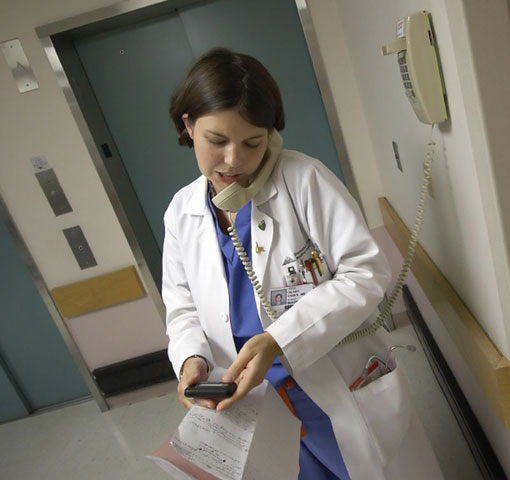Imagine a schedule where you could work any day you wanted, see as many (or few) patients as you wanted, and take as many holidays as you wanted.
Sound unbelievable?
Dr. Marko Duic has honed a physician scheduling system that delivers MD choice, MD control and a perfect fit between physician speed and patient volumes. He shares how he does it:
Welcome, Marko. You’ve figured out a way to give physicians choice, control and as many holidays as they want. Is that true?
For individual physicians, it’s true. The only restriction is that a few physicians need to stick around to keep the emerg going–so not everyone can take off at the same time. This might be an issue if everyone in the department wants to go to the same conference. But if an individual physician wants to go off for 3-6 months, to, say, cycle from Cairo to Capetown, it’s not a problem.
How long have you been doing this for?
Since 2001
How do the physicians like it?
They state that it’s a major reason why they’d never go to another ED to work.
How do patients like it – what results do you achieve?
The most important patient satisfaction correlate is their time to see the doctor (Physician Initial Assessment time). Well, the two hospitals in Ontario that use this system are often number 1 and number 2 in PIA times, and one of them is definitely a leader in satisfaction among peers.
What do the nurses think of this system?
At first, not that pleased that we could muster up ANY number of physicians ANY time, and they would get stuck with a pile of orders. They had to see that a pile of orders is better than a pile of unseen patients. At least with the patients having been seen by MDs, nurses could be asked to do the most urgent orders first. What the nurses like about his system is that there are always enough doctors to see the patients, so they never have to get abused by impatient patients. There’s never a day when three slow physicians work back to back and the place explodes.
Could this system work anywhere; do you think you could teach others to do it?
Of course it could work anywhere. It’s how patients would schedule doctors, if patients were allowed to schedule us.
Most emergency departments schedule a fixed number of shifts every single day, but you don’t. Why?
Each physician has a number of patients per shift that the physician is most comfortable seeing. It could be 15, could be 30, could be 45, could be 60. And each emergency department has a number of patients that they see any given day. So for example, in one of our departments, we see 300 on Sundays and Mondays and 270 the other five days. So I have to schedule enough physicians that their combined capacity to see patients adds up to the number of patients I’m expecting. So if all the fast docs go on a conference together, the slow remaining ones have to be scheduled in larger numbers–maybe 9 or 10 of them in a given day to see that many patients. If the slow guys go on a conference, I might only need five or six of the remaining fast docs to see the patients. If everyone’s in town, and I alternate fast and slow docs, I might need 7 or 8 physicians. If the physicians are different speeds, how can you expect to have the same number of them per day?
So, how do you determine exactly how fast each MD works?
I have stats, but they don’t really work that well. So I do it by trial & error repetition and intuition.
But what if more patients arrive on a particular day?
Shifts start when patient waits get up to a certain level. Physicians call each other to figure out when the next one needs to show up. If the day’s busier, it becomes evident in the conversations. Physicians come in early, and stay late, and if needed, call an extra physician.
And what if you need another physician to help?
We use our on-call funds to pay one of them to show up. We call in turn, alphabetically, and change the order by one physician each time, so everyone gets a chance.
Who decides if more MDs are needed on any given day?
The physicians who are working in the department at the time. If they risk running over the target patient waiting time, they call extra help in.
What if the physicians working that day do NOT call for extra help?
Then the times go over, this is a disaster, and they need to explain why they don’t.
What are your thoughts on the provincial Hospital On-Call funding system?
It’s good to have money to pay physicians to come in to serve patients. Especially in the ED, where volumes and acuities are unpredictable, and where timely access to care is what’s held out to the public in the name EMERGENCY DEPARTMENT that’s posted on the door.
Are there times when you have scheduled too many MDs on one day? What happens then?
They either shorten all the shifts, or cancel one of them, or both. They come to an agreement that suits them all.
Okay, let’s focus on the mechanics of schedule creation. How do physicians ‘pick their shifts’?
They submit a selection form that shows me when they want to work, when they can work, when they would prefer not to work, and when they can’t work. I use all the physicians’ forms to give everyone a schedule that’s almost entirely made up of shifts they want or can do.
Is it completely different every month?
Basically, yes. Some patterns repeat–some people like nights; other people like Wednesday mornings; some people can never work Friday evenings. But overall, it’s different every month.
What happens if there are too many shifts requested by the group?
Everyone gets a bit less than they asked for.
What happens if you can’t provide enough coverage to meet the expected volumes on a day?
Short term, everyone works a bit more than they would like. Long term, hire more people. But if it’s one day, and no one wants to work then, then there’s a lottery.
Can MDs take holidays?
Yes, any time, for any length of time. We’ve had people take full-year sabbaticals or 4 to 6 months LOAs and come back to a full shift roster. This system is totally flexible. 20 doctors can cover the absence of 1-2 docs with minimal disruption for a long time.
What if everyone wants to take holidays at the same time?
Then we close the department. No, seriously, there’s a max of about 1/3 of the department that can be on holidays for a longer period, or 1/2 the department for a few days, or 2/3 for a day or two, and it can still have full staffing.
What about Christmas, New Years and summer vacation – how do you handle those holiday requests?
In whatever way EPs want, but overall, some people always want to work them, and if there are not enough, then there’s always the record of who did it last year and the year before–those people get first dibs on taking them off this year.
Wow – this seems too good to be true, but it looks like the results prove it works. Do you have any final comments?
Try it, you’ll like it. More importantly, the physicians will love it and insist on always doing it this way. Patients will love it too.
 Sometimes patient volumes swamp the emergency department team. Most on-call systems work so poorly, they aren’t worth discussing. Here’s a great on-call system that actually benefits patients.
Sometimes patient volumes swamp the emergency department team. Most on-call systems work so poorly, they aren’t worth discussing. Here’s a great on-call system that actually benefits patients.
